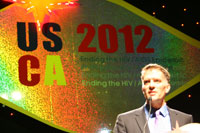U.S. Conference on AIDS – More Highlights from Day 2
Topics

At the annual U.S. Conference on AIDS on Monday, Dr. Grant Colfax, Director of the White House Office of National AIDS Policy (ONAP), offered a plenary speech on the implementation of the National HIV/AIDS Strategy. Describing the NHAS as a road map for all public and private stakeholders, he highlighted a number of its key facets, including:
- Engaging multiple federal agencies and the programs they support in its implementation;
- Emphasis on aligning resources where the epidemic is most concentrated and in populations with greatest disparities;
- Applying evidence-based approaches; and
- Focusing on improving coordination and efficiency across and within Federal, state, local and tribal governments
Continuing the conversation from the conference’s first plenary, Dr. Colfax discussed the impact of HIV/AIDS on women in the United States, observing that they now account for 23 percent of new infections and that Black and Latina women are disproportionately affected. Further, he noted that gay and bisexual men continue to comprise the largest proportion—nearly two-thirds—of new HIV infections in this country. Many racial and ethnic disparities persist across the HIV treatment cascade, Dr. Colfax noted. With the treatment cascade, he observed, we now have a framework for assessing progress in combating HIV as reflected in our achieving improvements in each step of the cascade and, ultimately, durable viral suppression for all people living with HIV.
Dr. Colfax pointed to the expansion of health care coverage under the Affordable Care Act as a key facilitator of efforts to advance toward that goal. Of people living with HIV/AIDS in the U.S., only 13 percent have private health insurance, nearly 25 percent have no insurance at all, and 47 percent receive Medicaid. He noted that the health care law will expand health care coverage to over 30 million Americans when fully implemented. In the meantime, significant changes have already been brought about by the law, he noted. These include:
- 54 million additional Americans are receiving preventive services;
- More than 3 million newly insured young adults are insured on their parent’s private insurance;
- Hundreds of persons living with HIV now covered under Pre-existing Condition Insurance Plans; and
- Increased investment in community health centers, where HIV care can be provided.
Dr. Colfax also noted that the Affordable Care Act delivers a number of important benefits for women. As of August of this year, 47 million women now have guaranteed access to additional preventative services without cost sharing, including: well-woman visits and screening and counseling for HIV, and domestic violence. When the law is fully implemented in 2014, insurers will not be able to deny coverage to women based on pre-existing conditions, including pregnancy, and insurers will not be able to charge women higher premiums than men.
Dr. Colfax reminded the USCA participants that HIV tracks other social and economic disparities in this nation, including education, poverty, unemployment, and homelessness. Thus, closing gaps in the treatment cascade and achieving the NHAS goals will not be achieved solely by expanding HIV treatment and health insurance coverage. Indeed, Dr. Colfax argued that a combination approach to HIV prevention and care is essential.
Given the progress implementing the NHAS to date—some of which is documented in ONAP’s Update of Federal Efforts to Implement the National HIV/AIDS Strategy, the opportunities that are being realized with the implementation of the Affordable Care Act, and the continued efforts of all stakeholders, including all of the conference participants, Dr. Colfax expressed confidence that by continuing to work together, we will implement the National HIV/AIDS Strategy and meet the President’s vision of an AIDS free generation.